Yen Softens as Aussie Extends Rally Amid Improved Risk Sentiment | 23rd July 2025

Aussie Rallies, Yen Slips
Markets traded with mixed momentum on Wednesday, July 23, 2025, as optimism surrounding renewed US-China trade talks lifted risk sentiment, supporting the Australian Dollar. Meanwhile, the Japanese Yen weakened sharply amid political uncertainty at home. WTI crude extended its losses below $65.50 on lingering demand concerns, while the PBOC’s slightly stronger CNY fix signaled a cautious policy stance.
AUD/JPY Forecast
Current Price and Context
AUD/JPY extended gains on Tuesday, trading near the 96.50 mark as broad-based Yen weakness drove the cross higher. However, the pair struggled to find momentum above mid-96.00s amid cautious risk appetite and lack of fresh bullish triggers.
Key Drivers
Geopolitical Risks: Japanese domestic political instability continues to weigh on the Yen, with concerns over leadership approval ratings and policy continuity dampening safe-haven demand.
US Economic Data: Softer US indicators have reduced expectations of immediate Fed tightening, prompting a general risk-on tone that favors yield-sensitive currencies like the Aussie.
FOMC Outcome: Dovish Fed commentary has shifted investor preference toward higher-yielding assets, reducing demand for safe havens such as the Yen.
Trade Policy: Positive developments in US-China negotiations are boosting optimism in the Asia-Pacific region, which indirectly benefits the AUD.
Monetary Policy: Divergence between the RBA’s cautious tone and the Bank of Japan’s ultra-loose stance continues to widen, keeping upward pressure on the cross.
Technical Outlook
Trend: The short-term bias remains bullish but appears to be losing steam as the pair hits strong resistance.
Resistance: Immediate resistance lies at 96.80, followed by 97.20 if momentum resumes.
Support: Key support is seen at 95.90, with a deeper pullback exposing 95.50.
Forecast: AUD/JPY may remain elevated but lacks clear follow-through above 96.50–97.00, suggesting consolidation unless fresh catalysts emerge.
Sentiment and Catalysts
Market Sentiment: Overall sentiment favors risk assets, but hesitation at higher levels reflects underlying caution in the FX space.
Catalysts: A surprise in Japanese macro data or any shift in BOJ rhetoric could trigger renewed Yen strength, while further trade optimism may lift AUD/JPY above recent highs.
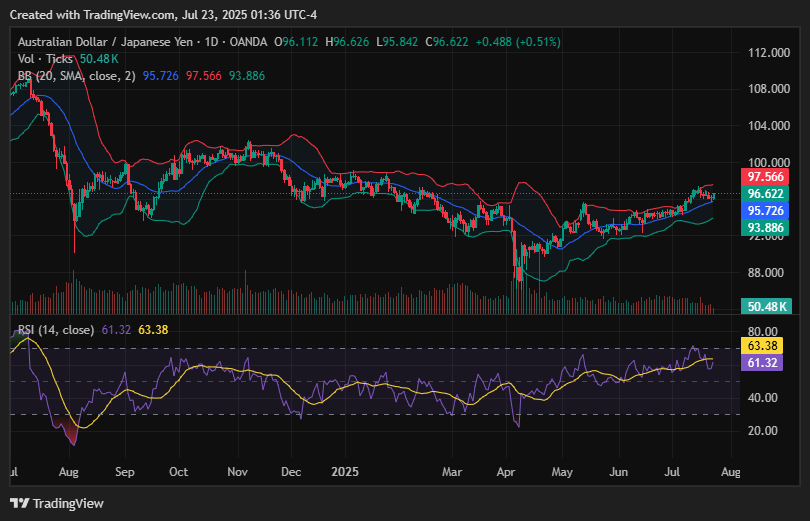
Australian Dollar (AUD/USD) Forecast
Current Price and Context
AUD/USD climbed to 0.6785 on Tuesday, supported by renewed optimism around US-China trade negotiations. A broadly weaker US Dollar and upbeat regional sentiment helped the Aussie extend its recent rebound, although near-term resistance capped further upside.
Key Drivers
Geopolitical Risks: Easing tensions between the US and China have brightened the outlook for Australian exports, given Australia’s trade dependence on China.
US Economic Data: Weaker US PMI and consumer data reduced bets on Fed hawkishness, dragging the greenback lower and providing a tailwind for AUD/USD.
FOMC Outcome: Markets are increasingly pricing in a policy pause or potential rate cuts in late 2025, placing downward pressure on the USD.
Trade Policy: Positive progress in US-China trade dialogue has improved risk appetite across Asia-Pacific markets, boosting AUD as a pro-growth currency.
Monetary Policy: RBA’s reluctance to ease despite global dovish tilt adds resilience to AUD, especially against a softening USD.
Technical Outlook
Trend: The pair is recovering from last week’s lows, showing early signs of a bullish reversal.
Resistance: Key resistance is located at 0.6800, followed by 0.6845, which coincides with the 100-day MA.
Support: Initial support lies at 0.6740, with further downside limited to 0.6700 unless sentiment turns.
Forecast: AUD/USD may aim for a test of the 0.6800–0.6840 zone if trade optimism holds and the USD stays weak.
Sentiment and Catalysts
Market Sentiment: Risk-on flows are favoring commodity currencies like the AUD, while USD softness continues to amplify the move.
Catalysts: Any further breakthroughs in US-China negotiations or dovish Fed commentary could drive fresh upside in AUD/USD.
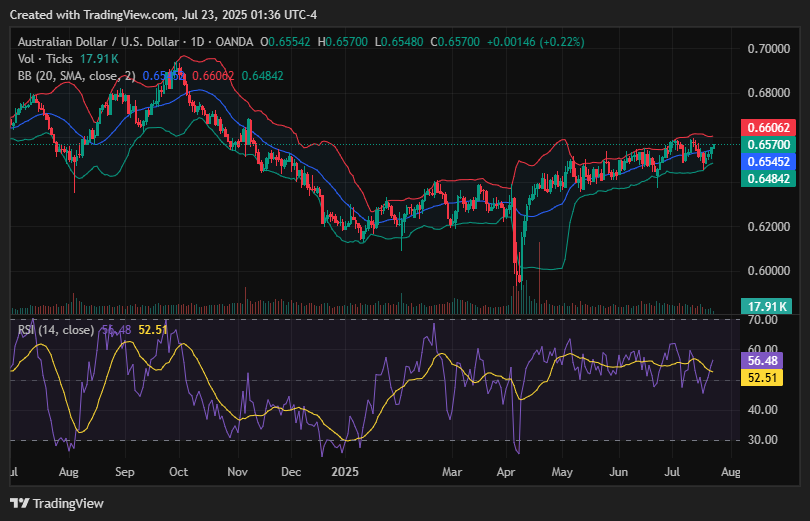
Japanese (USD/JPY) Forecast
Current Price and Context
USD/JPY rebounded sharply to 157.85, reversing earlier losses after hitting a two-week low near 156.20. The sudden yen sell-off was driven by heightened political uncertainty in Japan and firmer U.S. yields, which halted safe-haven flows.
Key Drivers
Geopolitical Risks: Domestic political instability in Japan raised investor caution, undermining demand for the yen despite global risk aversion.
US Economic Data: Resilient U.S. PMI and housing data pushed Treasury yields higher, boosting USD/JPY as interest rate differentials widened.
FOMC Outcome: Hawkish Fed rhetoric continues to support the USD, especially against currencies like the yen that are tethered to ultra-loose monetary policy.
Trade Policy: Little trade-related news directly impacting JPY, but overall sentiment around global growth continues to affect safe-haven dynamics.
Monetary Policy: BoJ maintains dovish stance, with no indication of rate hikes, further weakening the yen versus USD, which remains yield-attractive.
Technical Outlook
Trend: USD/JPY remains in a broader uptrend despite recent volatility.
Resistance: Immediate resistance lies at 158.20, followed by 159.00, a level tested earlier this month.
Support: Initial support is seen near 157.00, with stronger demand around the 156.20 recent low.
Forecast: USD/JPY may resume its climb toward 158.50–159.00 if U.S. yields continue to rise and Japanese political concerns persist.
Sentiment and Catalysts
Market Sentiment: Risk appetite is moderately supported by U.S. data, but yen sentiment is fragile amid Japan’s political uncertainty.
Catalysts: Developments in Japanese leadership stability and further moves in U.S. yields will steer near-term direction in USD/JPY.
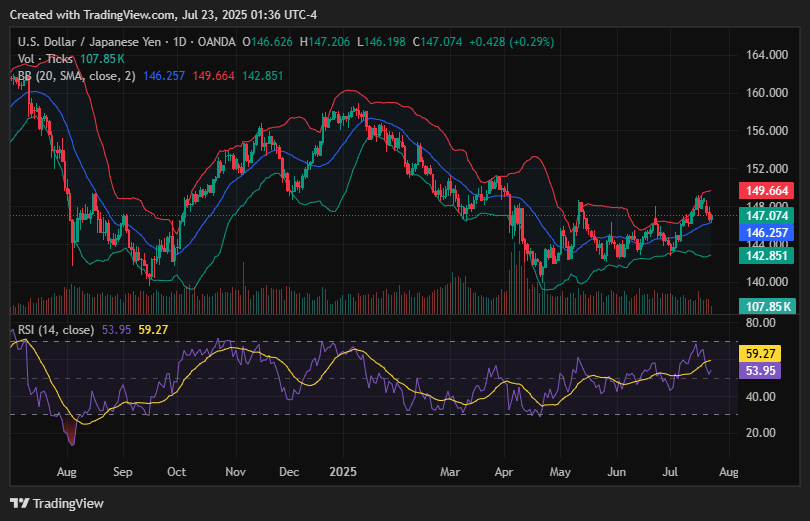
USD/CNY Forecast
Current Price and Context
USD/CNY trades near 7.1490 after the PBoC set the daily reference rate at 7.1414, slightly stronger than the previous fix of 7.1460. The central bank’s action shows continued efforts to manage yuan stability amid ongoing economic and geopolitical headwinds.
Key Drivers
Geopolitical Risks: Lingering concerns over U.S.-China trade and tech tensions remain, but no fresh escalation has surfaced.
US Economic Data: Firm U.S. data supports the dollar, keeping USD/CNY elevated despite the PBoC’s attempts to slow depreciation.
FOMC Outcome: Fed’s hawkish stance maintains pressure on the yuan as U.S.-China rate differentials stay wide.
Trade Policy: Progress in U.S.-China trade talks has marginally improved sentiment, but structural tensions persist.
Monetary Policy: PBoC remains accommodative with targeted stimulus, while keeping FX interventions subtle to prevent sharp yuan declines.
Technical Outlook
Trend: Sideways to mildly bullish bias for USD/CNY as the pair holds above 7.1400.
Resistance: Upside barriers appear at 7.1550, then 7.1620.
Support: Immediate support sits at the 7.1400 level, followed by the 7.1300 zone.
Forecast: USD/CNY may remain range-bound between 7.1400–7.1600, as the PBoC manages volatility while the USD remains underpinned.
Sentiment and Catalysts
Market Sentiment: Cautious optimism on China’s recovery and trade progress is tempered by U.S. dollar strength and policy divergence.
Catalysts: Further PBoC moves, incoming Chinese data, and U.S. rate expectations will shape next direction for USD/CNY.
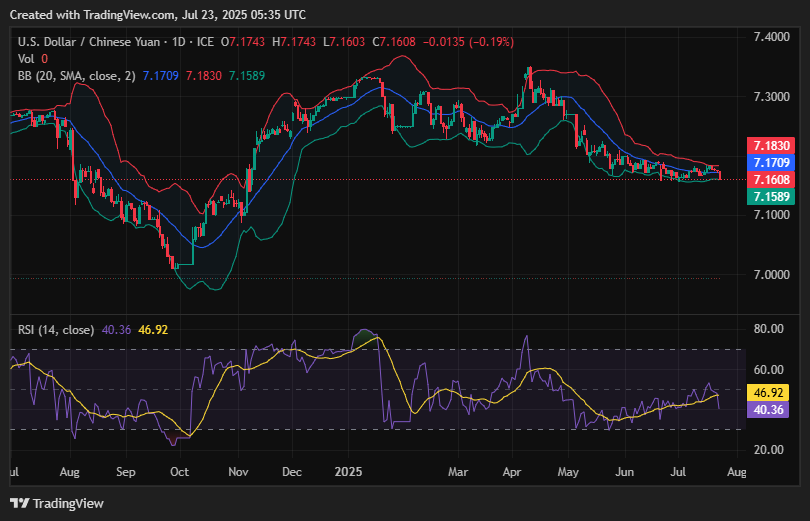
WTI Crude Oil Forecast
Current Price and Context
WTI crude oil slid to $65.30, extending its decline amid mounting concerns over global oil demand. Weak industrial data from China and rising U.S. inventories have pressured prices lower, with traders reassessing the outlook for energy consumption in the second half of 2025.
Key Drivers
Global Supply Concerns: Middle East tensions remain subdued, offering limited support to prices.
Geopolitical Risks: Escalating US-China tariff concerns revive demand-side caution.
US Economic Data: Rising stockpiles and softer gasoline demand from EIA reports suggest weaker short-term consumption.
FOMC Outcome: Hawkish Fed tone reinforces recession fears, dampening oil demand outlook.
Trade Policy: Uncertainty over U.S.-China trade dynamics adds to the cautious sentiment in commodity markets.
Monetary Policy: Global tightening bias continues to weigh on growth expectations and energy usage.
Technical Outlook
Trend: Bearish; WTI has broken below key support zones and shows no signs of a reversal yet.
Resistance: First resistance at $66.20, followed by $67.50.
Support: Initial support lies at $65.00, with next levels near $63.40.
Forecast: WTI may test deeper lows toward $64.50–$63.00 unless fresh demand signals or supply disruptions emerge.
Sentiment and Catalysts
Market Sentiment: Risk-averse as demand signals weaken and macroeconomic outlook dims.
Catalysts: Next EIA inventory data, Chinese manufacturing PMIs, and geopolitical surprises will be crucial for price direction.
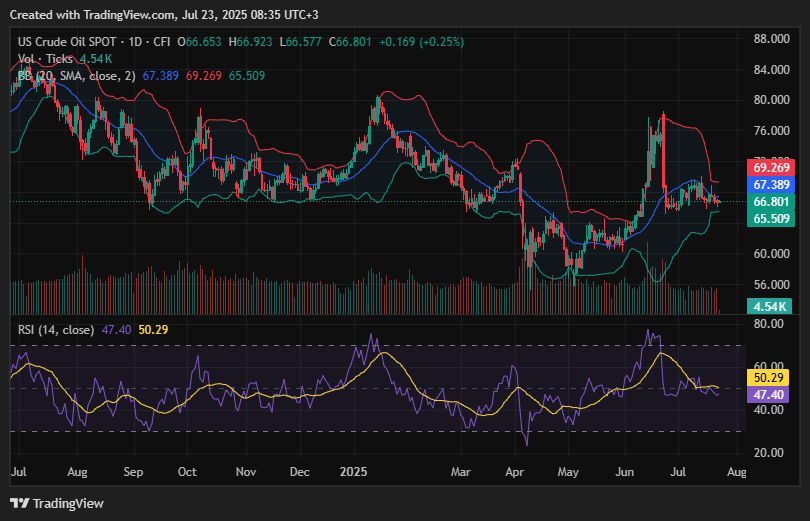
Wrap-up
In summary, risk-on flows dominated the session, helping commodity currencies like the Aussie extend gains, while safe-haven assets such as the Yen came under pressure. Oil’s continued slump reflected persistent demand uncertainty, but overall market sentiment improved slightly as trade optimism resurfaced. Traders now turn their attention to upcoming macro data and central bank cues for further direction.
Ready to trade global markets with confidence? Join Moneta Markets today and unlock 1000+ instruments, ultra-fast execution, ECN spreads from 0.0 pips, and more! Start now with Moneta Markets!





















